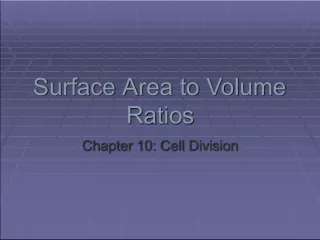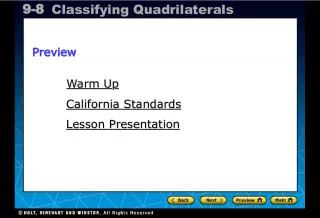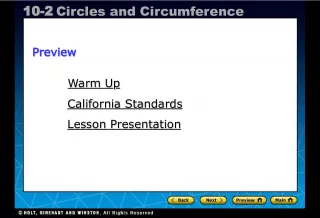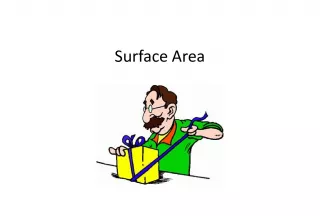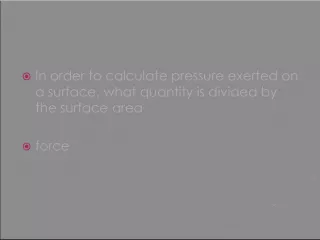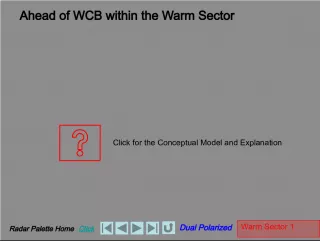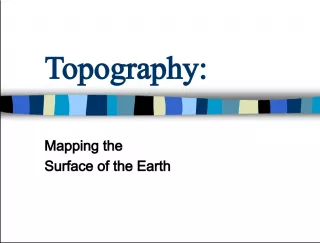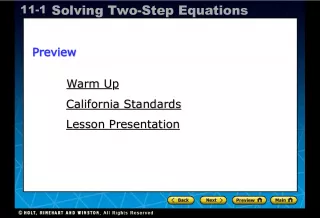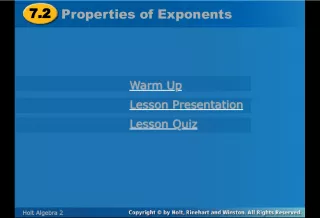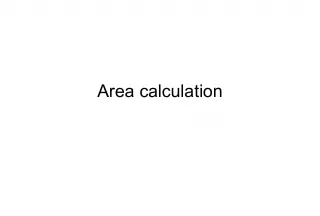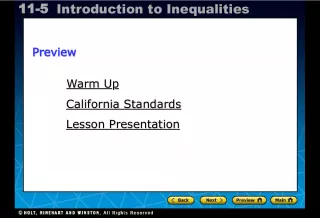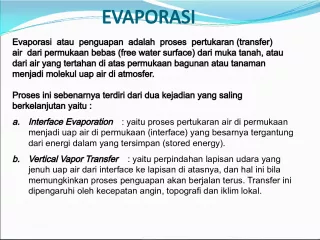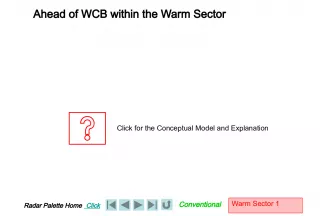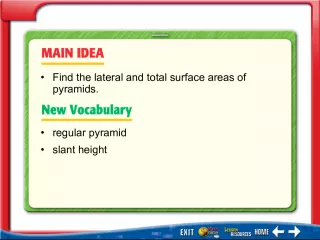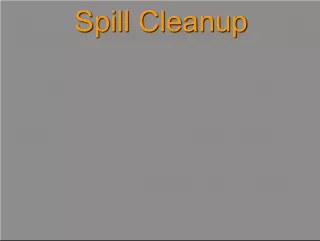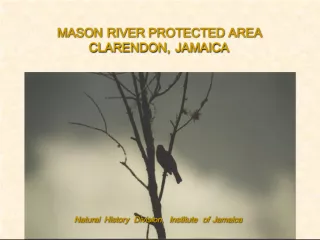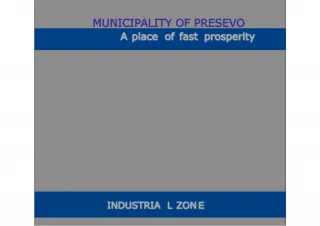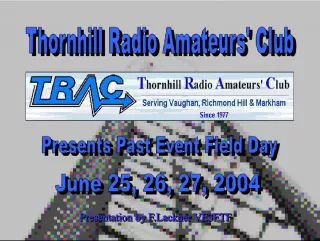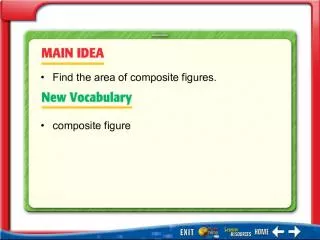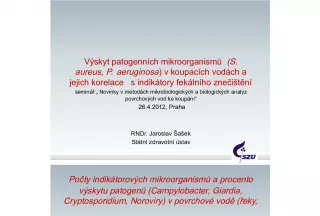Holt CA Course 110-10 Surface Area Warm Up


This lesson is designed to warm students up for surface area calculations by reviewing basic geometric figures. The lesson presentation includes descriptions of two types of figures: a prism with two parallel
- Uploaded on | 1 Views
-
 brettclarke
brettclarke
About Holt CA Course 110-10 Surface Area Warm Up
PowerPoint presentation about 'Holt CA Course 110-10 Surface Area Warm Up'. This presentation describes the topic on This lesson is designed to warm students up for surface area calculations by reviewing basic geometric figures. The lesson presentation includes descriptions of two types of figures: a prism with two parallel. The key topics included in this slideshow are . Download this presentation absolutely free.
Presentation Transcript
Slide1Holt CA Course 110-10 Surface Area Warm Up Warm Up Lesson Presentation Lesson Presentation California Standards California Standards Preview Preview
Slide2Holt CA Course 110-10 Surface Area Warm Up Identify the figure described. 1. two parallel congruent faces, with the other faces being parallelograms 2. a polyhedron that has a vertex and a face at opposite ends, with the other faces being triangles prism pyramid
Slide3Holt CA Course 110-10 Surface Area AF3.1 Use variables in expressions describing geometric quantities (e.g., P = 2 w + 2 l , A = bh , C = d –the formulas for the perimeter of a rectangle, the area of a triangle, and the circumference of a circle, respectively). Also covered: AF3.2 California Standards 1 2
Slide4Holt CA Course 110-10 Surface Area Vocabulary surface area net
Slide5Holt CA Course 110-10 Surface Area The surface area of a three- dimensional figure is the sum of the areas of its surfaces. To help you see all the surfaces of a three-dimensional figure, you can use a net . A net is an arrangement of two-dimensional figures that can be folded to form a three-dimensional figure.
Slide6Holt CA Course 110-10 Surface Area The surface area of a cylinder equals the sum of the area of its bases and the area of its curved surface. To find the area of the curved surface of a cylinder, multiply its height by the circumference of the base. Helpful Hint
Slide7Holt CA Course 110-10 Surface Area Additional Example 1: Finding the Surface Area of a Prism Find the surface area S of the prism. A. Method 1: Use a net. Draw a net to help you see each face of the prism. Use the formula A = lw to find the area of each face.
Slide8Holt CA Course 110-10 Surface Area Additional Example 1A Continued A : A = 5 2 = 10 B : A = 12 5 = 60 C : A = 12 2 = 24 D : A = 12 5 = 60 E : A = 12 2 = 24 F : A = 5 2 = 10 S = 10 + 60 + 24 + 60 + 24 + 10 = 188 Add the areas of each face. The surface area is 188 in 2 .
Slide9Holt CA Course 110-10 Surface Area Additional Example 1: Finding the Surface Area of a Prism Find the surface area S of each prism. B. Method 2: Use a three-dimensional drawing. Find the area of the front, top, and side, and multiply each by 2 to include the opposite faces.
Slide10Holt CA Course 110-10 Surface Area Additional Example 1B Continued Front : 9 7 = 63 Top : 9 5 = 45 Side : 7 5 = 35 63 2 = 126 45 2 = 90 35 2 = 70 S = 126 + 90 + 70 = 286 Add the areas of each face. The surface area is 286 cm 2 .
Slide11Holt CA Course 110-10 Surface Area Additional Example 2: Finding the Surface Area of a Pyramid Find the surface area S of the pyramid. S = area of square + 4 (area of triangular face) S = 49 + 4 28 S = 49 + 112 Substitute. S = s 2 + 4 ( bh ) 1 2 __ S = 7 2 + 4 ( 7 8 ) 1 2 __ S = 161 The surface area is 161 ft 2 .
Slide12Holt CA Course 110-10 Surface Area Additional Example 3: Finding the Surface Area of a Cylinder Find the surface area S of the cylinder. Write your answer in terms of . S = area of curved surface + (2 area of each base) Substitute 7 for h and 4 for r. S = ( h 2 r ) + (2 r 2 ) S = ( 7 2 4 ) + (2 4 2 ) ft S = (7 2 4)+ (2 16) Simplify the power.
Slide13Holt CA Course 110-10 Surface Area Additional Example 3 Continued Find the surface area S of the cylinder. Write in terms of . S = (56 + 32) The surface area is about 88 ft 2 . Multiply. S = 88 S = 56 + 32 Use the Distributive Property.
Slide14Holt CA Course 110-10 Surface Area Check It Out! Example 1 Find the surface area S of each prism. B. Method 2: Use a three-dimensional drawing. Find the area of the front, top, and side, and multiply each by 2 to include the opposite faces. 6 cm 10 cm 8 cm top front side
Slide15Holt CA Course 110-10 Surface Area Check It Out! Example 1B Continued Side : 10 8 = 80 Top : 10 6 = 60 Front : 8 6 = 48 80 2 = 160 60 2 = 120 48 2 = 96 S = 160 + 120 + 96 = 376 Add the areas of each face. The surface area is 376 cm 2 . 6 cm 10 cm 8 cm top front side
Slide16Holt CA Course 110-10 Surface Area Check It Out! Example 2 Find the surface area S of the pyramid. S = area of square + 4 (area of triangular face) S = 25 + 4 25 S = 25 + 100 Substitute. S = s 2 + 4 ( bh ) 1 2 __ S = 5 2 + 4 ( 5 10 ) 1 2 __ S = 125 The surface area is 125 ft 2 . 5 ft 5 ft 10 ft 10 ft 5 ft
Slide17Holt CA Course 110-10 Surface Area Check It Out! Example 3 Find the surface area S of the cylinder. Write your answer in terms of . S = area of lateral surface + (2 area of each base) Substitute 9 for h and 6 for r. S = ( h 2 r ) + (2 r 2 ) S = ( 9 2 6 ) + (2 6 2 ) 6 ft 9 ft S = (9 2 6) + (2 36) Simplify the power.
Slide18Holt CA Course 110-10 Surface Area Check It Out! Example 3 Continued Find the surface area S of the cylinder. Write your answer in terms of . S = (108 + 72) S = 180 The surface area is about 180 ft 2 . Multiply. S = 108 + 72 Use the Distributive Property.
Slide19Holt CA Course 110-10 Surface Area Lesson Quiz Find the surface area of each figure. Use 3.14 as an estimate for . 1. rectangular prism with base length 6 ft, width 5 ft, and height 7 ft 2. cylinder with radius 3 ft and height 7 ft 3. Find the surface area of the figure shown. 214 ft 2 ≈188.4 ft 2 208 ft 2
